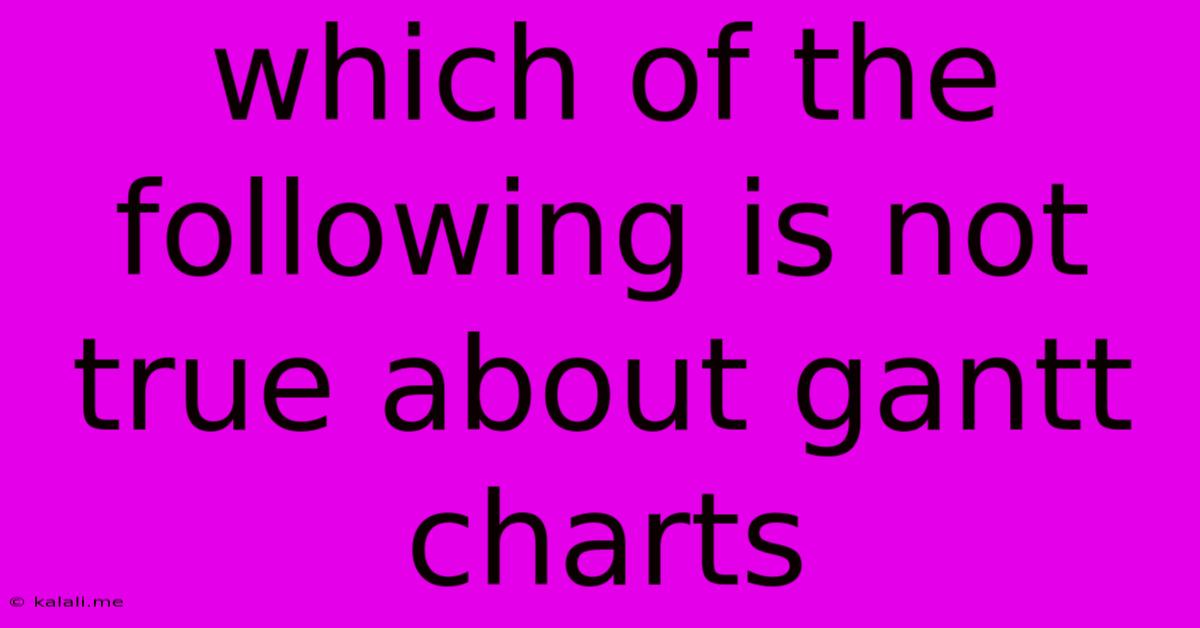Which Of The Following Is Not True About Gantt Charts
Kalali
Jun 13, 2025 · 3 min read

Table of Contents
Which of the Following is NOT True About Gantt Charts? A Comprehensive Guide
Gantt charts are ubiquitous in project management, offering a visual representation of a project's schedule. They're known for their simplicity and effectiveness in communicating task dependencies, timelines, and progress. But even with their widespread use, some common misconceptions exist. This article will debunk those myths and clarify what isn't true about Gantt charts. We'll explore their strengths and limitations to provide a comprehensive understanding.
What are Gantt Charts? A Gantt chart is a horizontal bar chart that illustrates project schedules. Each bar represents a specific task or activity, its length corresponding to the task's duration. They visually depict task dependencies, milestones, and the overall project timeline. This visual representation makes it easy to understand the project's progress and identify potential delays or bottlenecks.
Misconceptions about Gantt Charts: What's NOT True?
Let's address some common misunderstandings surrounding Gantt charts:
1. Gantt Charts Are Only Suitable for Simple Projects: FALSE. While they are easy to understand for simpler projects, Gantt charts can effectively manage complex projects with multiple dependencies and tasks. Sophisticated software allows for the creation of detailed charts with numerous interconnected tasks, making them scalable for large-scale endeavors. The key is proper planning and breakdown of complex projects into manageable sub-tasks.
2. Gantt Charts Automatically Manage Resources: FALSE. While Gantt charts show the timeline of tasks, they don't inherently manage resource allocation. They illustrate when tasks need to be completed, but not necessarily who will complete them or what resources are required. Resource management is a separate process that often needs to be integrated with the Gantt chart, possibly through supplementary tools or spreadsheets.
3. Gantt Charts Predict the Future with 100% Accuracy: FALSE. Gantt charts are planning tools, not predictive models. They rely on estimated task durations and dependencies, which can be subject to change. Unforeseen issues, delays, or resource constraints can easily impact the accuracy of the projected timeline. Regular updates and revisions are crucial for maintaining the relevance and accuracy of the chart throughout the project lifecycle.
4. Gantt Charts Replace Detailed Project Planning: FALSE. Gantt charts are a visual representation of a project plan. They don't replace the need for thorough planning, which includes defining scope, outlining tasks, identifying dependencies, estimating resources, and risk assessment. A well-constructed Gantt chart stems from a robust and well-defined project plan.
5. Gantt Charts are Only Useful During Project Execution: FALSE. While Gantt charts are valuable during project execution for monitoring progress, they are equally useful during the planning phase. Creating the chart itself forces a structured approach to task breakdown and sequencing, aiding in early identification of potential problems. The chart also serves as a valuable communication tool throughout the project lifecycle.
The True Power of Gantt Charts:
Despite these misconceptions, Gantt charts remain a powerful project management tool. Their key strengths include:
- Visual Clarity: The visual representation provides a clear and easy-to-understand overview of the project schedule.
- Improved Communication: The chart simplifies communication among team members and stakeholders.
- Enhanced Task Management: It helps in tracking progress, identifying delays, and managing dependencies effectively.
- Better Resource Allocation (with supplemental tools): When combined with appropriate resource management tools, Gantt charts can provide a more comprehensive view of resource allocation and utilization.
By understanding the limitations and capabilities of Gantt charts, project managers can utilize this powerful tool effectively to improve project planning, execution, and overall success. Remember, accurate and effective use depends on thorough planning, regular updates, and potentially integrating it with other project management techniques.
Latest Posts
Latest Posts
-
How To Write 800 In Words
Jun 14, 2025
-
What Is The Last Step In The Communication Process
Jun 14, 2025
-
What Is The Resistance Of An Ideal Voltmeter
Jun 14, 2025
-
Which Of The Following Is A Decomposer
Jun 14, 2025
-
Which Of The Following Is An Example Of A Saprotroph
Jun 14, 2025
Related Post
Thank you for visiting our website which covers about Which Of The Following Is Not True About Gantt Charts . We hope the information provided has been useful to you. Feel free to contact us if you have any questions or need further assistance. See you next time and don't miss to bookmark.